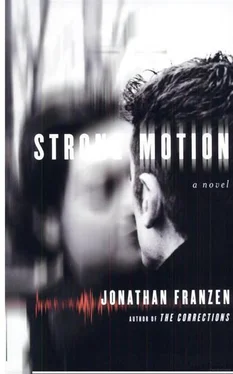Friendless, Renée saw stereotypes everywhere she looked. Her head was full of images of women, and she hated most the ones she most resembled.
The well-spoken and socially concerned and humorless and defensive female academic.
The thin, vulnerable, self-absorbed, vaguely haunted-looking single woman who is either a spiritual seeker or simply a loser and probably the latter.
The unsatisfied thirty-year-old professional female who sees the error of her ways and begins to crave a baby.
The boring scientist who lives in a computer room but considers herself less boring than others like her because ten years ago she went to Clash concerts.
The girl who, not having many female friends, grew up reading science fiction and science and popular philosophy and who, as a woman, is still so romantic as to believe in things like corporate malfeasance and heroes who make a difference.
The medium-attractive female academic who in her quest to feel very attractive acquires the reputation of an easy lay.
The woman who cannot get along with other women and who hangs out with men and who in the course of time ends up sleeping with many of them and who, a traitor to her own sex, is respected by men only to the extent that she is like a man.
The medium-attractive and well-spoken academic female whom no one likes but who nevertheless considers herself extremely special and lovable and unusual and wears a certain smile that shows this and is therefore disliked all the more.
As the hateful stereotypes homed in on her, the only thing that saved her from concluding that all she really hated was herself was her selfconsciousness. selfconsciousness was a guardian angel that accompanied her everywhere. In grocery stores it told her how to select foods — apples, eggs, fish, bread, butter, broccoli — that could be trusted not to put words in her mouth. Words like I am a yuppie or I am trying hard not to be a yuppie or See how original I am or See how timid I am as I try to avoid being like the people I don’t want to be, including those who are selfconsciously original . It required daily vigilance to keep herself from cooking like well-educated thirty-year-olds on TV, or like gastronomes who became orgasmic over nice pasta, or like women on a magazine diet, or like men who thought it made them sexy and sophisticated to cook with capers and chuckle greedily about ’71 Richebourgs. Or, conversely, like people who never gave a thought to food. Because unfortunately eating junk was not an option. In the future she imagined for herself, she would not be eating junk. She could hardly swallow junk.
Similarly, she couldn’t bring herself to wear ugly clothes or to furnish her apartment with trash. In fact, when she shopped in a department store, the clothes and utensils that struck her as unimplicating invariably turned out to be the most expensive in their class. Clearly, if you were rich enough, transparency could be purchased. Not being rich, she faced the task of finding attractive and moderately priced things while avoiding every implicating mass-produced contemporary style. This hunt for neutral tops and neutral shoes and neutral outerwear and neutral chairs was time-consuming and made her all the more painfully aware of herself.
She hated new things “inspired by” old things — products soiled by a modern designer’s nostalgia for the fifties or the twenties. The old things themselves she could trust, provided they hadn’t passed through the soiling hands of a consciousness like her own. It had been a pleasure to outfit her apartment from a naïve flea market held weekly in the Somerville Library parking lot. But when she stepped into a “vintage” clothing store, even a store with nice merchandise, she felt faint and ill and soon fled. Only in a naïve thrift store, such as the Salvation Army ran, could she hope to hold out long enough to find something, and then only if she was not in Boston, because in Boston these stores were haunted by other bargain-hunting young people dangerously similar to herself.
Once every month or two, year in, year out, she thought of the clothes her mother hadn’t given her.
They had come to light during her family’s last year in Lake Forest, when everyone but Renée was about to move to California. She discovered them in a roomful of belongings bound for Goodwill. She was rescuing one last armful of them — some classic narrow skirts, a jacket with an emerald-green velvet collar, a bright red high-waisted hourglass dress, a checkered wool overcoat, a pair of black-on-brown saddle shoes — when her mother caught her.
“What are you doing with these?”
“I’m sorry. I’m sorry. I thought you were throwing them away.”
“I am throwing them away.”
“Well, can’t I have them, then?”
“I’m giving them to Goodwill. Please put them back where you found them.”
“Why can’t I have them?”
“Honey, you have so many outfits in your closet that you’ve hardly even tried on. What do you need these old things for?”
“They’re nice. I want them. Please let me have them.”
Her mother shook her head sadly. “I’m very sorry if you had your heart set on these. But I don’t want you wearing them.”
“Oh, why not, why not, why not?”
“I just don’t want to see you wearing them. They have associations for me.”
“But I’m going away. You won’t see me.”
“You know I’ll buy you anything you want. Things just like this. New things, better things. But think about if you had a boyfriend, that you broke up with. Would you give him to your best friend?”
“These are clothes .”
“For me it’s the same thing,” her mother said.
Renée marched unsteadily out of her own bedroom, eyes brimming. Her mother didn’t bend. The clothes went to Goodwill. In her memory they remained the most beautiful clothes she’d ever seen, the most perfect imaginable clothes for her. She might not have trusted her memory, except that there were pictures of the clothes in the family photo albums — pictures of the young Beth Macaulay on a tour of Europe that lasted through six seasons, pictures of the checkered coat in the Bois du Bologne. The checkered coat in Dublin. The striped sundress at Berck-Plage. Beth Macaulay in Arles, her perfect skin, her black-rimmed, black-lensed sunglasses, her funky saddle shoes, her diary. Her red dress in black-and-white in Rome. Her checkered coat in Venice.
She was three months pregnant when she married Daniel Seitchek, a young cardiologist from a West Side family of wholesalers and junior-college intellectuals. How painfully pained and washed out the young and pretty Elizabeth looked in black-and-white (the soot black of South Chicago, the white of fresh snow, the black-and-white of her checkered coat) as she held up her bundled baby girl for the camera.
How difficult it was to reconcile these images with the pink and white and kelly-green golfing outfits and tennis outfits worn by the woman Renée grew up knowing as her mother. This woman who eventually, in California, would drive a car with a plate that said MOMS JAG to high-school baseball games and sit in the stands with other mothers as tan as Egyptians and scream at her boys’ successes and groan laughingly and cover her eyes at their failures. This woman who in her daughter’s hearing once described herself as “kind of a Pollyanna,” and who confessed to being “addicted” to the novels of Tom Clancy. The pictures of the beautifully clad Beth Macaulay in Europe seemed to say that she had once been more like Renée — more romantic, more independent — than anyone watching her little skirts flounce around a tennis court would ever guess. Being afraid of death, Renée wanted to believe that despite their different circumstances she had exactly the same soul as her mother. And it was tempting to let the likelihood of the identity, the common sense of the assumption, stand as a certainty. Unfortunately, she was also rational, and she refused to believe she was the same person as this partygoing Orange County Pollyanna without some sort of proof. And it just so happened that the years when her mother had been a different and presumably more Renée-like individual were precisely the years before there was any such person as Renée.
Читать дальше
Конец ознакомительного отрывка
Купить книгу












